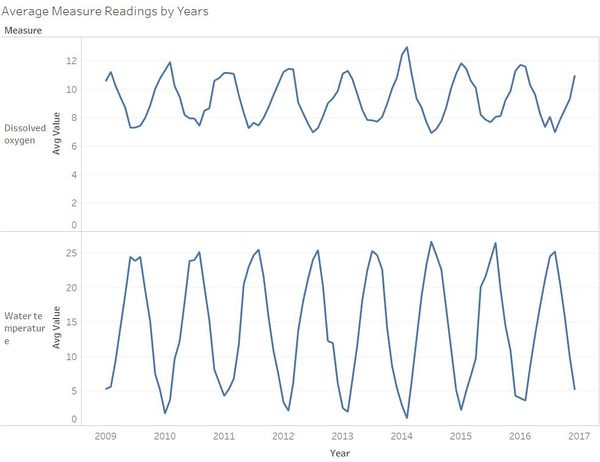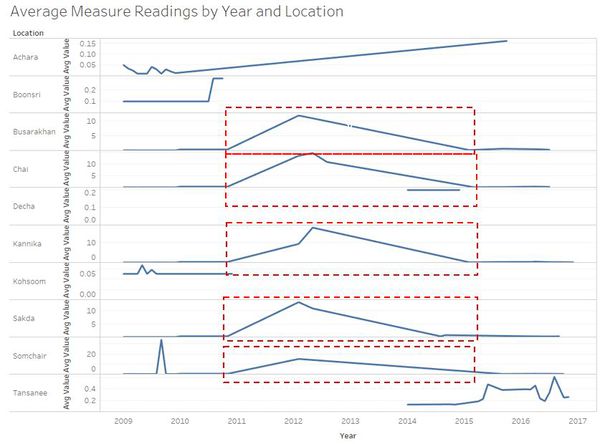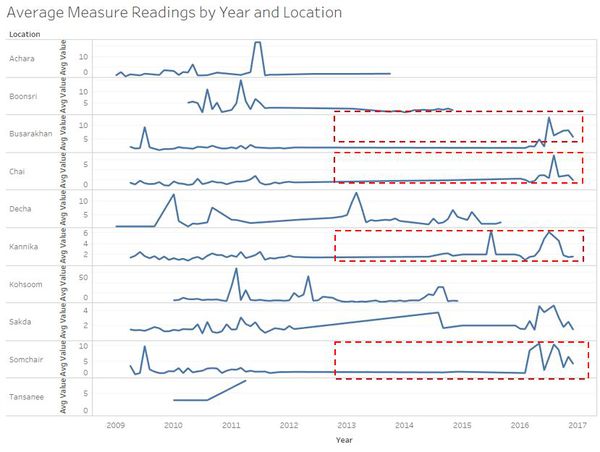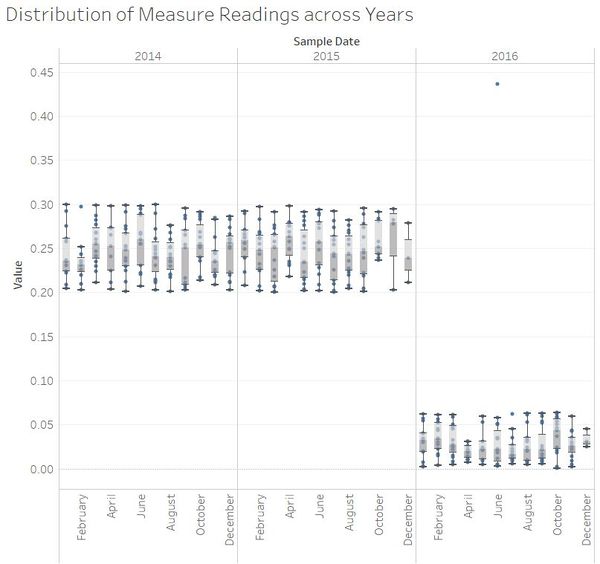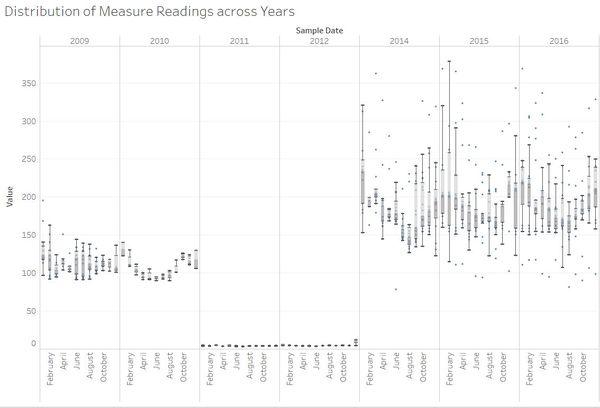Difference between revisions of "ISSS608 2017-18 T3 Assign Kalai Selvi Methodology and Dashboard Design"
Kalaisr.2017 (talk | contribs) |
Kalaisr.2017 (talk | contribs) |
||
| Line 29: | Line 29: | ||
<font size="3"><font face=""Calibri" color="#0e68ce">'''Cyclic Trend in Dissolved Oxygen and Water Temperature observed across the years'''</font></font><br> | <font size="3"><font face=""Calibri" color="#0e68ce">'''Cyclic Trend in Dissolved Oxygen and Water Temperature observed across the years'''</font></font><br> | ||
| + | Average monthly dissolved oxygen levels in the waterways consistently declines from January to July/August each year. Increasing trend in average monthly dissolved oxygen levels is observed from August to December for each year. On the other hand, increasing trends in monthly average water temperature readings is observed from January to August and average monthly water temperature readings decline from August to December for each year. | ||
| − | |||
[[File:11.jpg|600 px]] | [[File:11.jpg|600 px]] | ||
<font size="3"><font face=""Calibri" color="#0e68ce">'''Consistent Patterns for Petroleum Hydrocarbons across locations '''</font></font><br> | <font size="3"><font face=""Calibri" color="#0e68ce">'''Consistent Patterns for Petroleum Hydrocarbons across locations '''</font></font><br> | ||
| + | There was an increasing trend in the average monthly Petroleum hydrocarbons readings from November 2010 to around February 2012 for Busarakhan, Somchair and Tansanee locations and an upwards trend from November 2010 to May 2012 for Chai and Kannika locations. After the upward spike, a decreasing trend was seen in the average monthly Petroleum hydrocarbons readings for all 5 locations. | ||
| − | |||
[[File:12.JPG|600 px]] | [[File:12.JPG|600 px]] | ||
<font size="3"><font face=""Calibri" color="#0e68ce">'''Consistent Patterns for Petroleum Hydrocarbons across locations '''</font></font><br> | <font size="3"><font face=""Calibri" color="#0e68ce">'''Consistent Patterns for Petroleum Hydrocarbons across locations '''</font></font><br> | ||
| − | The average | + | The average monhtly Nickel measure readings follows the same pattern for Chai, Kannika, Sakda, Busarakhan and Somchair locations. |
| − | + | ||
[[File:13.JPG|600 px]] | [[File:13.JPG|600 px]] | ||
<font size="3"><font face=""Calibri" color="#0e68ce">'''Decreasing Trends in Methylosmoline '''</font></font><br> | <font size="3"><font face=""Calibri" color="#0e68ce">'''Decreasing Trends in Methylosmoline '''</font></font><br> | ||
| − | + | The Methylosmoline levels has been consistent for 2014 and 2015. The Methylosmoline readings recorded in 2016 are much lower compared to 2014 and 2015 readings. The range of Methylosmoline values were wider in 2014 and 2015 as seen from the inter quartile range of the boxplots. | |
| − | The Methylosmoline levels has been consistent for 2014 and 2015. The Methylosmoline readings recorded in 2016 are lower | ||
[[File:14.jpg|600 px]] | [[File:14.jpg|600 px]] | ||
<font size="3"><font face=""Calibri" color="#0e68ce">'''Increasing Trends in Total Hardness levels'''</font></font><br> | <font size="3"><font face=""Calibri" color="#0e68ce">'''Increasing Trends in Total Hardness levels'''</font></font><br> | ||
| − | |||
Total hardness levels have been generally declining from 2006 to 2010, and the value of the readings are closer to each other in range, especially from years 2008 to 2010 as seen as the smaller IQR. The total hardness levels were lowest in 2011 and 2012. The total hardness levels are higher for 2014 to 2016 and the first quartile is also at a higher value compared to previous years. There are a higher number of skewed readings; above the 3rd quartile for 2014 to 2016. | Total hardness levels have been generally declining from 2006 to 2010, and the value of the readings are closer to each other in range, especially from years 2008 to 2010 as seen as the smaller IQR. The total hardness levels were lowest in 2011 and 2012. The total hardness levels are higher for 2014 to 2016 and the first quartile is also at a higher value compared to previous years. There are a higher number of skewed readings; above the 3rd quartile for 2014 to 2016. | ||
Revision as of 22:02, 7 July 2018
Question 1: Characterize the past and most recent situation with respect to chemical contamination in the Boonsong Lekagul waterways. Do you see any trends of possible interest in this investigation?
Cyclic Trend in Dissolved Oxygen and Water Temperature observed across the years
Average monthly dissolved oxygen levels in the waterways consistently declines from January to July/August each year. Increasing trend in average monthly dissolved oxygen levels is observed from August to December for each year. On the other hand, increasing trends in monthly average water temperature readings is observed from January to August and average monthly water temperature readings decline from August to December for each year.
Consistent Patterns for Petroleum Hydrocarbons across locations
There was an increasing trend in the average monthly Petroleum hydrocarbons readings from November 2010 to around February 2012 for Busarakhan, Somchair and Tansanee locations and an upwards trend from November 2010 to May 2012 for Chai and Kannika locations. After the upward spike, a decreasing trend was seen in the average monthly Petroleum hydrocarbons readings for all 5 locations.
Consistent Patterns for Petroleum Hydrocarbons across locations
The average monhtly Nickel measure readings follows the same pattern for Chai, Kannika, Sakda, Busarakhan and Somchair locations.
Decreasing Trends in Methylosmoline
The Methylosmoline levels has been consistent for 2014 and 2015. The Methylosmoline readings recorded in 2016 are much lower compared to 2014 and 2015 readings. The range of Methylosmoline values were wider in 2014 and 2015 as seen from the inter quartile range of the boxplots.
Increasing Trends in Total Hardness levels
Total hardness levels have been generally declining from 2006 to 2010, and the value of the readings are closer to each other in range, especially from years 2008 to 2010 as seen as the smaller IQR. The total hardness levels were lowest in 2011 and 2012. The total hardness levels are higher for 2014 to 2016 and the first quartile is also at a higher value compared to previous years. There are a higher number of skewed readings; above the 3rd quartile for 2014 to 2016.
Question 2: What anomalies do you find in the waterway samples dataset? How do these affect your analysis of potential problems to the environment? Is the Hydrology Department collecting sufficient data to understand the comprehensive situation across the Preserve? What changes would you propose to make in the sampling approach to best understand the situation?

